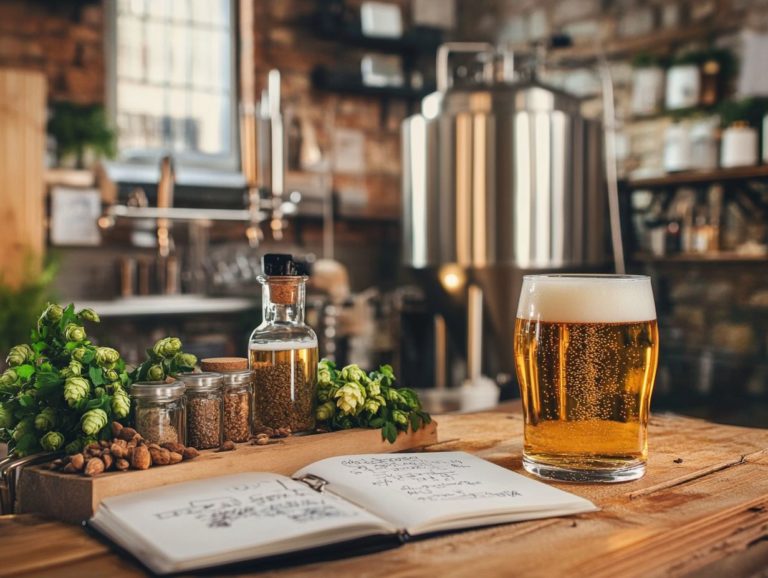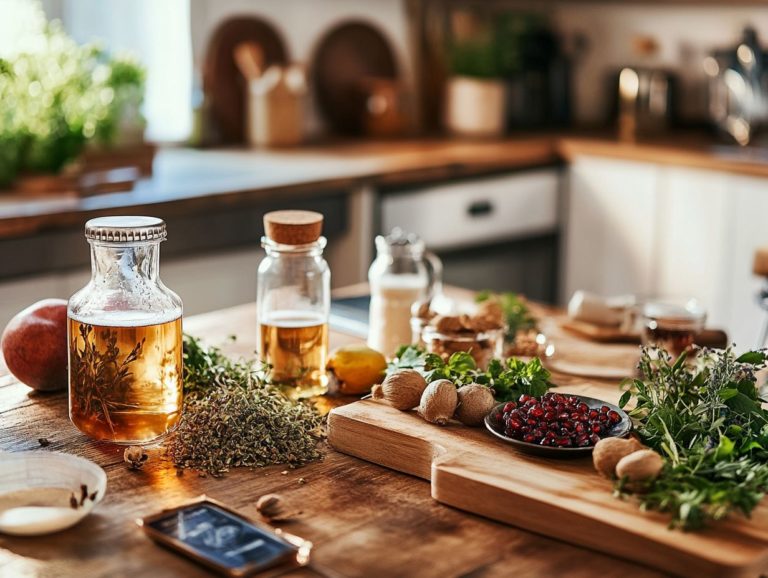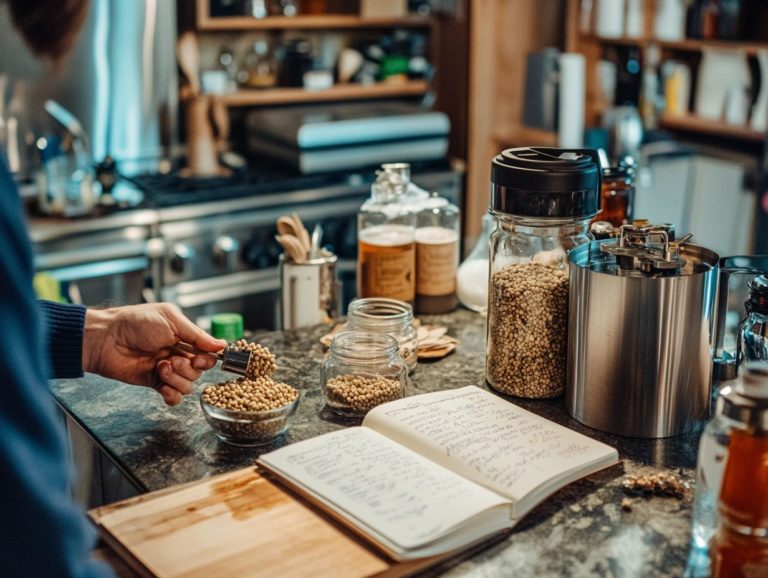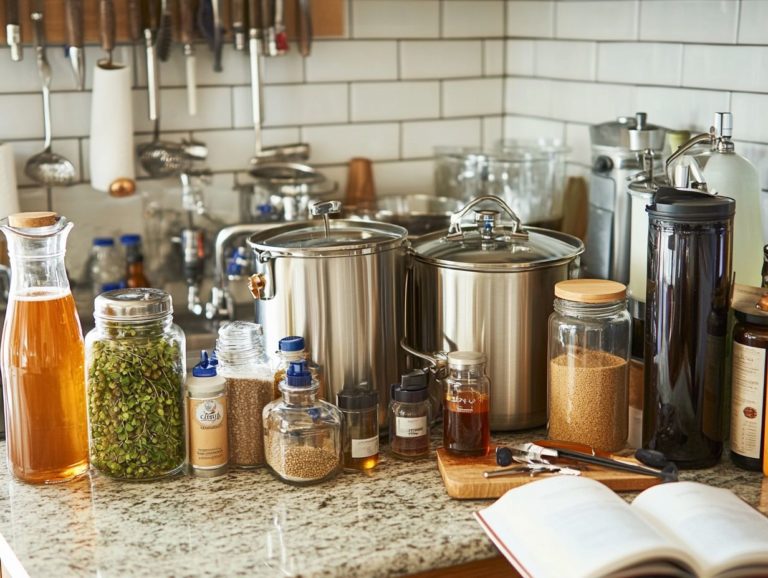10 Tips for Flavoring Your Home Brew
Are you ready to take your homebrewing to the next level? Crafting the perfect brew is truly an art form, and the magic unfolds in the world of flavoring and brewing spices.
Whether you re a seasoned brewer or just dipping your toes into this delightful hobby, experimenting with ingredients, including cooking and culinary spices, can unlock a universe of delicious possibilities.
This article delves into ten essential tips that will elevate the flavor of your home brews from selecting fresh, high-quality ingredients to exploring unique hops, yeasts, and even fruits. You’ll discover the joy of incorporating spices like anise seed and lavender for unique flavors.
Get ready to craft brews that burst with flavor and showcase your unique style!
Contents
- Key Takeaways:
- 1. Experiment with Different Ingredients
- 2. Use Fresh, High-Quality Ingredients
- 3. Don’t Be Afraid to Mix Flavors
- 4. Consider Using Herbs and Spices
- 5. Add Fruit for a Burst of Flavor
- 6. Use Different Types of Hops
- 7. Try Different Yeast Strains
- 8. Use Specialty Malts
- 9. Consider Barrel-Aging Your Brew
- 10. Balance Your Flavors
- What Are the Best Ingredients for Flavoring Home Brew?
- How Can You Incorporate Fruits and Spices into Your Brew?
- What Are the Most Popular Flavors for Home Brews?
- How Can You Achieve a Balanced and Complex Flavor Profile?
- What Are the Common Mistakes to Avoid When Flavoring Home Brews?
- Frequently Asked Questions
- What are some tips for flavoring my home brew?
- Can I use any type of fruit to flavor my home brew?
- How much fruit should I add to my home brew for flavoring?
- Are there any herbs or spices that are commonly used for flavoring home brews?
- Flavors and Brewing Tips
Key Takeaways:

- Experiment with different ingredients to discover unique flavors for your home brew.
- Use fresh, high-quality ingredients to ensure the best possible taste in your brew.
- Don’t be afraid to mix flavors and get creative with herbs, spices, fruit, and more, including brewing spices like cardamom, basil, and turmeric.
1. Experiment with Different Ingredients
Homebrewing gives you the power to explore the exciting world of brewing, where you can experiment with various ingredients to create unique flavors that distinguish your brews from commercial examples.
Whether you re just starting your brewing journey or you re already a seasoned expert, the creative process of selecting and combining spices, fruits, and hops can profoundly influence the final flavor profile of your beer. Each batch becomes a personal masterpiece that embodies your distinct taste and passion for the craft.
At the core of homebrewing lies experimentation, inviting you to push the boundaries and craft flavors that are truly your own. For instance, incorporating spices like coriander or cinnamon can add warmth and complexity, while fresh fruits such as raspberries or citrus can introduce bright, refreshing notes. Hops, often regarded as the soul of beer, vary in aroma and bitterness, dramatically altering your brew s character.
To ensure your successful experiments can be replicated, it s crucial to document all measurements meticulously. Keep track of ingredient amounts, brewing times, and fermentation temperatures. Taking detailed tasting notes during the brewing and sampling process will help you capture the subtle nuances of each batch, paving the way for endless discoveries in your homebrewing adventure.
2. Use Fresh, High-Quality Ingredients
Using fresh, high-quality ingredients is essential in homebrewing, as they significantly influence the flavor and aroma of your craft beer, guaranteeing a delightful experience for everyone who enjoys your creations. Consider incorporating fresh herbs like sea salt, basil, and thyme for a truly unique touch.
The importance of sourcing top-notch hops, malts, and spices cannot be overstated; premium ingredients have the power to elevate your brew from ordinary to extraordinary. Freshness is paramount; stale or inferior ingredients can introduce off-flavors that ruin a meticulously crafted beer. You might want to explore local breweries or farmer s markets for seasonal and freshly harvested options. Specialty suppliers that prioritize artisanal goods are also excellent resources for unique varieties that can add distinct characteristics to your brew.
Once you’ve secured those prized ingredients, store them in a cool, dark place preferably in airtight containers to maximize their longevity. Proper storage prevents degradation and ensures that each brew reflects the quality and care you invested in its creation.
3. Don’t Be Afraid to Mix Flavors
Regarding homebrewing, don t hesitate to mix flavors; doing so can lead you to craft truly unique beers that surprise and delight your taste buds with every sip.
Imagine blending spices with fruits to create refreshing summer ales that are both zesty and aromatic. Consider using spices like cardamom and rosemary, which can add intriguing layers to your beer.
Picture yourself enjoying a wheat beer infused with coriander and orange peel, instantly transporting you to sun-soaked days at the beach.
Alternatively, experimenting with different hop varieties can introduce citrusy or earthy notes to your ales, adding layers of complexity. Imagine an IPA that marries Amarillo hops with Citra hops for a burst of tropical flavor!
These collaborations of flavors elevate your drinking experience and encourage you to embrace bold experimentation in your brewing adventures, much like the creativity seen in Italian cooking.
4. Consider Using Herbs and Spices
Incorporating herbs and spices such as allspice, nutmeg, cayenne pepper, and lavender into your brewing process can truly elevate your beer’s flavor profile, adding aromatic notes that create a more complex tasting experience.
Each of these ingredients offers something distinct. For example, allspice imparts a warm, sweet flavor that enhances the richness of stouts. Meanwhile, nutmeg lends a subtle, earthy nuance that s perfect for autumn ales.
Cayenne pepper, on the other hand, introduces a spicy kick that pairs wonderfully with hoppy IPAs.
When you re using these ingredients, timing and measurement are crucial aim for about 1 teaspoon per 5 gallons of beer. This is especially important for spices like ginger and anise seed, which can be overpowering if used excessively.
Adding them during the last 10-15 minutes of the boil will allow the flavors to meld beautifully without becoming overpowering. Alternatively, consider adding during fermentation for a more nuanced final product.
5. Add Fruit for a Burst of Flavor
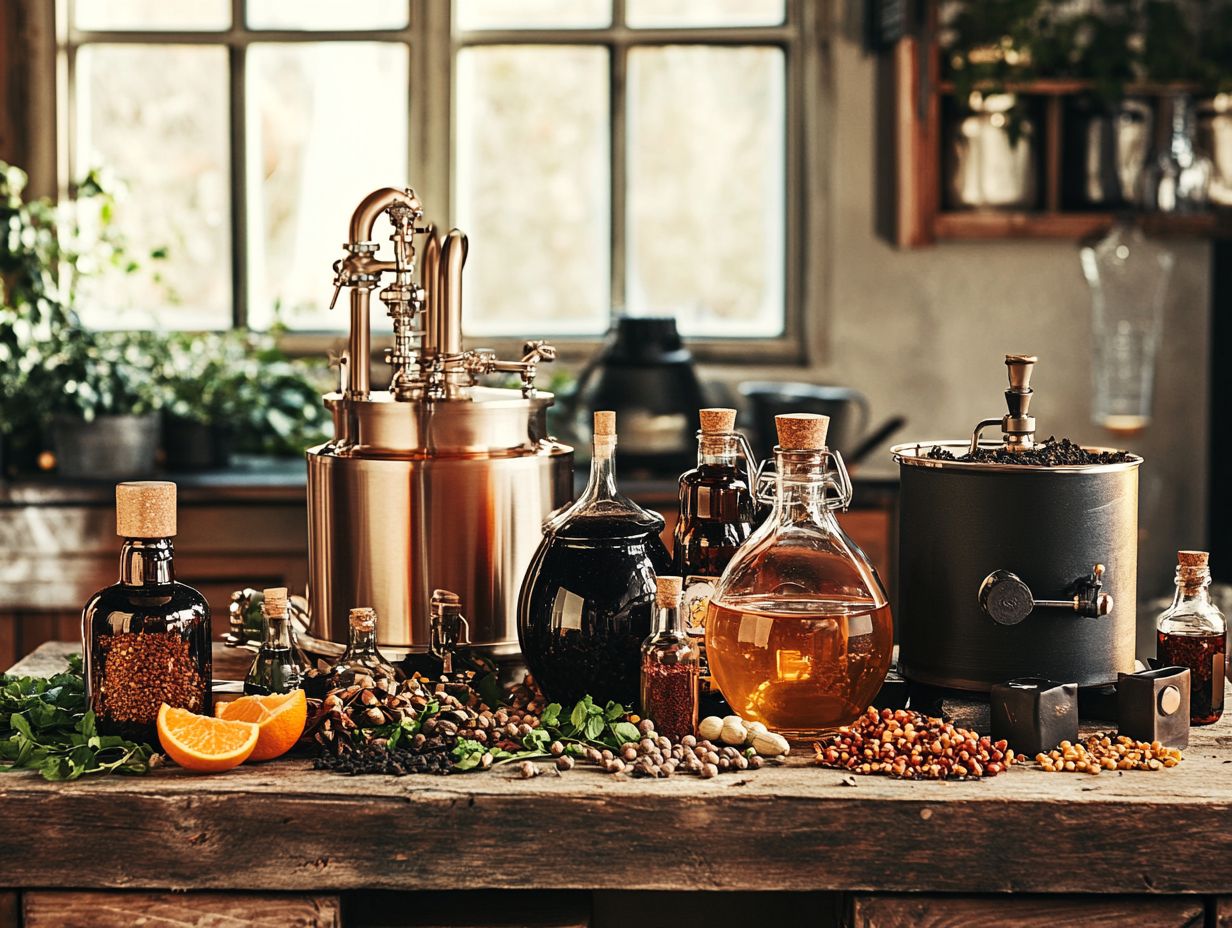
Adding fruit to your homebrew opens the door to a world of vibrant flavors and enticing aromas, transforming your craft beer into a refreshing experience that delights the senses.
This infusion can elevate a straightforward brew into something remarkable, captivating both seasoned beer aficionados and casual drinkers alike. For example, citrus fruits like oranges and grapefruits beautifully complement the hoppy notes of an IPA.
Berries introduce a delightful sweetness to stouts and porters. Incorporating seasonal fruits like pumpkin and cranberry during the holiday season not only imparts unique flavors but also creates a festive visual appeal.
Many brewers explore techniques like introducing fruit during fermentation or as a secondary addition, allowing for a more pronounced fruit character in the final product. Don t miss out on transforming your brew with these vibrant fruits this season!
6. Use Different Types of Hops
Utilizing different types of hops in your brewing process opens the door to a world of unique flavors and aromas, transforming your homebrewed beer into a distinctive craft masterpiece.
Imagine the bold bitterness of Centennial hops mingling with the citrusy burst of Citra; each variety boasts its own unique profile that enhances your beer experience. Incorporating spices like ginger or turmeric can add yet another layer of complexity.
Timing your hop additions is crucial: adding hops during the boil primarily contributes to bitterness, while making additions later in the boil elevates the flavor.
If you re aiming to amplify those aromatic qualities, consider using techniques like dry hopping, which involves introducing hop cones during fermentation. By exploring these varieties and techniques, you can gain a deeper understanding of how to craft beers that not only prioritize bitterness but also enchant the palate with remarkable complexity.
7. Try Different Yeast Strains
Exploring various yeast strains can profoundly influence your fermentation process and the flavor profiles of your homebrewed beer. This opens the door to endless possibilities in craft beer creation.
The yeast you choose doesn’t just contribute distinct flavors and aromas; it also affects the mouthfeel the way a beer feels in your mouth which is a critical element of your overall drinking experience. Yeast strains can also interact uniquely with spices, creating a symphony of flavors.
Each strain has its unique characteristics. For instance, some ales are known for their fruity esters, while others might impart a spicy or earthy quality.
When selecting the right yeast, it s essential to consider the style of beer you want to create. Some yeasts thrive at warmer temperatures, unleashing robust flavors, whereas others excel in cooler environments, resulting in cleaner, crisper profiles. Understanding these nuances empowers you to craft a beer that resonates with your intended flavor and texture.
8. Use Specialty Malts
Incorporating specialty malts into your brewing process can significantly elevate your craft beer. These malts add layers of depth and complexity, enhancing the flavor profile with rich, aromatic undertones.
These unique malts come in a variety of types, including caramel, chocolate, and roasted, each bringing its distinct characteristics to the table. Combining these malts with spices like anise seed and allspice can result in a truly unique brew.
For instance, caramel malts provide a delightful sweetness and a golden hue, while chocolate malts introduce darker colors and rich, coffee-like flavors that can transform your brew.
It s essential to balance these ingredients within your overall grain bill; your goal should be to complement the base malt s profile rather than overshadow it. By thoughtfully selecting and measuring your specialty malts, you can create a harmonious blend that allows the beer s overall flavor to shine, highlighting the intricate nuances these malts contribute.
9. Consider Barrel-Aging Your Brew
Ready to take your homebrew to the next level? Barrel-aging introduces unique flavors and complexity that will wow any beer lover!
This fascinating process involves storing your beer in wooden barrels, typically crafted from oak. The wood introduces a delightful range of flavors think vanilla, caramel, and a hint of toastiness thanks to the sugar compounds nestled within. Many homebrewers find this method crucial for creating optimal styles like holiday beers, especially pumpkin beers.
As you explore this journey, keep in mind the various types of barrels at your disposal. Whether you choose those previously used for bourbon, wine, or even spirits, each option will impart its distinct nuances. Don t forget that spices in beer can also add depth, much like the impact of the barrels themselves.
The aging duration is another variable to play with, ranging from a few months to several years, depending on how deep you want those flavors to develop. Don’t miss out! Grab a brew kettle and start experimenting with aging durations to see how they influence your beer recipes.
While your beer interacts with the wood, oxygen seeps into the barrel, creating a perfect environment for oxidation that enhances the overall profile. This method, reminiscent of traditional brewing techniques, can make your homebrew rival those from a professional brewery.
This process opens the door to experimentation feel free to mix and match different barrels and aging times. You might just stumble upon unexpected and delightful results, transforming a standard brew into something truly extraordinary.
10. Balance Your Flavors

Achieving a harmonious balance of flavors in your homebrew is essential for crafting a well-rounded craft beer that delights the senses and showcases your brewing prowess.
To create this balance, consider the interaction of key flavors such as bitterness, sweetness, acidity, and aroma. Bitterness, often derived from hops, serves as a counterpoint to the sweetness of malt.
Acidity introduces a refreshing brightness that enhances the entire profile.
As you taste your brew, take the time to identify and adjust these flavors gradually. Start by sampling small amounts and observing how each element interacts. Then, make adjustments as needed by altering ingredients or refining brewing techniques. Following 10 essential tips for brewing great beers can enhance this careful method, resulting in craft beer that delights your taste buds and showcases your brewing style.
What Are the Best Ingredients for Flavoring Home Brew?
Selecting the finest ingredients for flavoring your homebrew is essential for crafting a distinctive craft beer that reflects your personal taste and impresses those who savor your brewing creations.
At the heart of any exceptional brew lies the malt, which provides a rich canvas of sweetness and depth. Hops then take center stage, introducing an array of aromas ranging from floral to citrusy bitterness, skillfully balancing that sweetness.
Your choice of spices, like coriander or cinnamon, can elevate your recipe to new heights, adding intriguing layers of complexity that truly set your brew apart. Fruits such as raspberries or oranges not only enhance the visual appeal but also infuse delightful flavors that can brighten the entire drinking experience.
Yeast, a microorganism that ferments sugars to produce alcohol, plays a crucial role in fermentation, imparting subtle notes and complexity that can vary dramatically based on the strain you select. Consider popular combinations, such as zesty orange peel paired with citrusy hops or dark malts harmonizing with vanilla beans.
These pairings can create remarkable flavors that leave a lasting impression on any palate.
How Can You Incorporate Fruits and Spices into Your Brew?
Incorporating fruits and spices into your homebrew opens the door to an exciting and dynamic flavor profile, infusing your craft beer with a refreshing twist that elevates it to new heights.
Thoughtfully integrating these ingredients at various stages of brewing and fermentation allows you to achieve a harmonious balance that enhances your overall brewing experience. For those just starting out, utilizing essential home brewing tips for beginners is especially useful when brewing holiday beers that call for a mix of seasonal fruits and spices.
For example, adding zest or whole fruits during the boil imparts a robust essence, while introducing delicate fruits and spices during fermentation allows for a subtle infusion that won t overwhelm the base flavors.
Experiment with flavor pairings; citrus fruits, for instance, beautifully complement hoppy IPAs, adding a touch of brightness. Warm spices like cinnamon can enhance darker ales, creating complex layers that invite intrigue with every sip.
What Are the Most Popular Flavors for Home Brews?
Home brewers often find themselves drawn to popular flavors like citrusy hops, aromatic spices, and refreshing fruits, crafting beers that resonate with a broad audience and elevate the overall drinking experience.
These elements not only enhance the taste but also invite you into a vibrant world of sensory exploration. Citrus flavors, particularly those derived from American hops, shine in styles like India Pale Ales (IPAs), delivering that zesty kick that many craft beer enthusiasts crave.
The incorporation of spices, frequently featured in Belgian-style Witbiers, adds a layer of complexity and warmth, appealing to those seeking something both unique and familiar.
Fruits also play a crucial role consider the crisp apple notes found in a hard cider or the delightful essence of berries infused into a sour ale, which can provide a refreshing and unexpected twist. Popular additions include bay leaves, black pepper, and sweet leaves to create a uniquely flavored beer. These flavors cater to diverse palates, making your homebrewed creations all the more enticing.
How Can You Achieve a Balanced and Complex Flavor Profile?
Achieving a balanced and complex flavor profile in your homebrew requires a deep understanding of how ingredients interact and a meticulous approach to the brewing process. This balance is essential for crafting a satisfying drinking experience that delights the palate and invites further exploration of flavors.
To master this balance, focus on the interplay of sweetness, bitterness, acidity, and aroma. Tasting at various stages of the brewing process is crucial. Start by sampling the mash to appreciate the sweetness imparted by the malt. Then, assess the hop additions for their bitterness. After fermentation, evaluate the acidity levels and the aroma from the hops.
You can make adjustments by tweaking ingredient ratios or infusion times. This allows you to refine your final brew into something that truly captivates the taste buds. Drawing inspiration from Italian cooking, consider incorporating parsley or other herbs for a savory twist.
What Are the Common Mistakes to Avoid When Flavoring Home Brews?

As a new homebrewer, you may discover exciting new flavors. However, it s easy to stumble into common pitfalls when flavoring your brews, such as overloading on spices or failing to balance flavors properly, which can yield less than desirable results.
To steer clear of these missteps, start with small amounts of flavoring ingredients and gradually increase them, all while tasting your creations at each stage. Grasping the importance of different flavor profiles and their interactions is essential. For example, certain spices can quickly take center stage if not measured with care, while others may need more time to develop their character. Following guidelines like the Reinheitsgebot, which is a German beer purity law, can also help manage these flavors effectively.
Keep a vigilant eye on the brewing process and regularly sample your batch. This proactive approach allows you to make adjustments that elevate the final product, transforming your homebrew into something truly exceptional.
Frequently Asked Questions
What are some tips for flavoring my home brew?
- Experiment with different ingredients: Don t be afraid to try new flavors and combinations to find what suits your taste buds.
- Use fresh, high-quality ingredients: The fresher the ingredients, the better the flavor.
- Consider adding fruits and spices: Fruits like berries and spices like cinnamon can add a unique twist to your brew.
- Try different brewing methods: Changing up your brewing method can have a big impact on the flavor of your home brew.
- Don t overdo it: When it comes to flavoring, less is often more. Start with small amounts and adjust to your liking.
- Use natural flavorings: Avoid artificial flavorings and opt for natural options like fresh fruits, herbs, and spices.
- Consider the season: Use seasonal ingredients to add a touch of freshness and variety to your brew.
- Incorporate different textures: Adding creamy or chewy ingredients can give your brew a fun and unique texture.
- Age your brew: Some flavors may develop and become more pronounced with time, so be patient and let your brew age.
- Take notes: Keep track of the ingredients and methods you use to create your favorite flavors, so you can recreate them in the future.
Can I use any type of fruit to flavor my home brew?
Yes, you can use a variety of fruits to flavor your home brew. Some popular options include berries, citrus fruits, and tropical fruits. Don t forget to consider seasonal ingredients, which can help create distinctive craft beers that stand out.
How much fruit should I add to my home brew for flavoring?
The amount of fruit you add will depend on your personal preference and the strength of the fruit’s flavor. Start with small amounts and adjust to your liking.
Are there any herbs or spices that are commonly used for flavoring home brews?
Certain herbs and spices can add a unique and delicious twist to your home brew. Some popular options include cinnamon, ginger, and vanilla.
Flavors and Brewing Tips
How can I make sure the flavors I use complement each other?
Researching food pairing is an effective way to ensure your flavors complement each other. Certain fruits and spices, especially those used in Italian cooking, pair well, while others may clash.
Growing spices in your garden can offer fresher and more vibrant flavors. Have you tried pairing any unexpected flavors?
Can I use artificial flavorings to flavor my home brew?
You can use artificial flavorings, but they often lack the depth and complexity of natural ingredients. To achieve the best results, it s wise to stick with fresh, natural options.
Explore the world of natural ingredients to elevate your brews!

